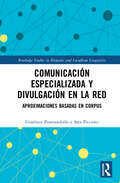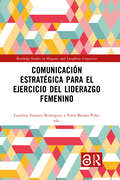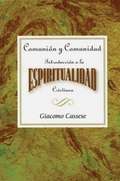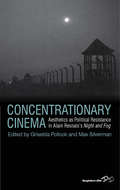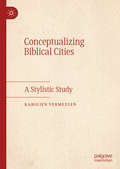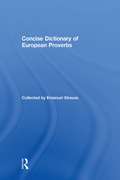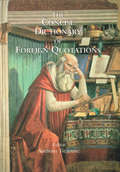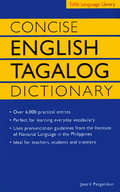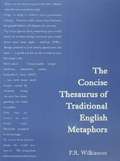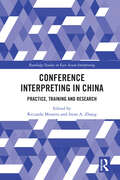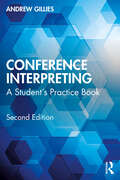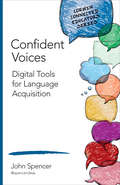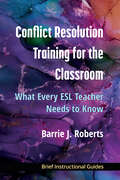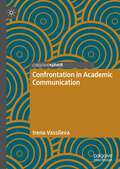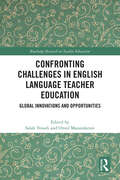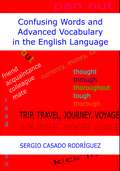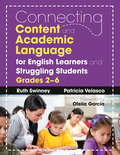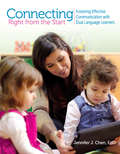- Table View
- List View
Comunicación especializada y divulgación en la red: aproximaciones basadas en corpus (Routledge Studies in Hispanic and Lusophone Linguistics)
by Gianluca Pontrandolfo Sara PiccioniComunicación especializada y divulgación en la red: aproximaciones basadas en corpus adopta un enfoque basado en corpus para analizar los principales rasgos discursivos de la divulgación y de la comunicación especializada en español. El volumen presenta un modelo teórico para el estudio de la divulgación en los géneros digitales y lo aplica a una serie de estudios de caso que analizan diferentes rasgos (entre otros, la metáfora, la polifonía o los encuadres discursivos) que permiten caracterizar cómo se comunican contenidos especializados a un público lego. La investigación se basa en el corpus WebLesp, que contiene distintos géneros digitales en cuatro ámbitos sectoriales: medicina, derecho, economía y ciencia. El volumen se dirige a investigadores expertos y principiantes, así como a alumnado y profesorado, interesados en la lingüística española, el análisis de género, el análisis del discurso, el español para fines específicos y la lingüística de corpus. Comunicación especializada y divulgación en la red: aproximaciones basadas en corpus presents a corpus-based approach to the study of the key features of popularization and specialised communication in Spanish. Providing a theoretical framework for the study of popularization in web genres, this book proposes a series of case studies exploring a range of features (including metaphor, polyphony and discourse frames) that contribute to characterise how specialised knowledge is communicated to lay audiences. The research is based on the WebLesp corpus, containing different web genres pertaining to four major domains: law, economics, medicine, and science. This will be of particular interest to researchers and advanced students in Spanish Linguistics, Genre Analysis, Discourse Analysis, Spanish for Specific Purposes and Corpus Linguistics.
Comunicación estratégica para el ejercicio del liderazgo femenino (Routledge Studies in Hispanic and Lusophone Linguistics)
by Catalina Fuentes Rodríguez Ester Brenes Peña, eds.Comunicación estratégica para el ejercicio del liderazgo femenino ofrece una importante contribución al estudio de la lingüística de género y análisis del discurso en español. Este monográfi co reúne investigaciones basadas en corpus que proporcionan un análisis detallado del género y el discurso de las mujeres líderes o profesionales en dominios históricamente dominados por hombres, como son los negocios, la ciencia, los medios y la política. Basado en el análisis de textos reales, el volumen busca determinar qué rasgos son verdaderamente características del discurso femenino, cómo las mujeres que han conseguido triunfar en estos dominios han usado su discurso para crear y proyectar su propia identidad y qué conclusiones se pueden obtener acerca de las características del discurso de la mujer líder. Además, incorpora una perspectiva diacrónica que nos ayuda comprender la evolución del papel y el discurso de y sobre las mujeres. La colección será de interés para investigadores en Análisis del Discurso, Español Aplicado a la Lingüística, Sociolingüística Hispánica y Comunicación y Género. Comunicación estratégica para el ejercicio del liderazgo femenino offers an important contribution to the study of gender linguistics and Spanish discourse analysis. This edited collection brings together corpus-based research to provide a detailed analysis of gender and the discourse of women leaders or professionals in domains historically dominated by men, such as business, science, media and politics. Based on the analysis of real texts, the volume seeks to determine which traits are truly characteristic of feminine discourse, how women who have been successful in these domains have used their discourse to create and project their own identity, and what conclusions can be drawn regarding the characteristics of the discourse of successful female leaders. It incorporates a diachronic perspective that helps us understand the evolution of the role and discourse of and about women. The collection will be of interest to researchers in Spanish Applied Linguistics, Hispanic Sociolinguistics and Communication and Gender Studies.
Comunión y comunidad: Communion and Community An Introduction to Christian Spirituality Spanish
by Abingdon Giacomo Cassese“La vida en comunidad es lo más esencial de la espiritualidad cristiana, y es la esencia misma del reino de Dios... La espiritualidad cristiana consiste en un nuevo modo de relacionarnos en amor, pues es precisamente esto lo que claramente distingue a la comunidad creyente de cualquier otra comunidad humana”. Al definir así la espiritualidad cristiana, el Dr. Cassese derriba el obsoleto paradigma que intentaba buscar la perfecta relación con Dios a través del aislamiento, de la pura relación personal e individual con Dios. En particular porque en realidad es en la comunidad donde la espiritualidad se realiza, se prueba, se evalúa, crece y se perfecciona. Este libro, por lo tanto, nos ayudará a comprender y vivir la espiritualidad desde la vida cotidiana en comunidad, desde la inter-relación e inter-acción con nuestros hermanos y hermanas, desde la inmersión profunda en la vida misma.ENDOSO AL LIBRO COMUNIÓN Y COMUNIDADPor Roberto Amparo Rivera, PhD La iglesia como institución tradicionalmente ha reflejado en la práctica las tendencias y valores de la sociedad en que se desenvuelven. Por eso no es de maravillarse encontrar hoy día creyentes individualistas y congregaciones que son más grupos de individuos que comunidades integradas. A pesar de que el amor de Dios, que supuestamente distingue la comunidad, “no busca lo suyo”, los miembros de estas iglesias se preocupan más de sus propios intereses que del bienestar comunitario. En este estado de cosas, el libro Comunión y comunidad, de Giacomo Cassese, es un grito de alerta y una invitación a recobrar el sentido comunitario de la fe cristiana. Hay una opinión generalizada de que la cultura occidental es cada vez más espiritualista. En este contexto, la espiritualidad se mide en términos de prácticas esotéricas de meditación, ayuno, contemplación de la naturaleza y lecturas de documentos misteriosos de religiones orientales. La contraparte cristiana percibe la espritualidad solo en su dimensión vertical; “el alma en relación con Dios”, mientras que el resto de la vida no hace ninguna aplicación a las relaciones diarias con los semejantes. En marcado contraste, Cassese define espiritualidad como un estilo de relacionarse y de vivir en comunidad. Para los cristianos, afirma el autor, espiritualidad conlleva vivir la vida en su plenitud y con propósito. Solo en la comunión con Cristo nos entendemos como personas de comunidad. Y es a partir de la persona de Cristo que descubrimos la dignidad de los demás como personas. Solamente recibiendo a nuestros hermanos y hermanas como regalo de Dios, y experimentando a través de las comunión con ellas y ellos la encarnación de la Trinidad, tendremos la vida en abundancia que el camino hacia Dios promete. Comunión y comunidad es un oasis al espíritu solitario que aun no ha descubierto que su mayor riqueza está en la vida relacional con sus hermanos y hermanas en Cristo. La lectura es amena y fácil de seguir. Cassese se esmera por hacer comprensibles los términos teológicos que emplea. Con marcada paciencia toma de la mano a los lectores y lectoras y les guía con su habilidad característica a través de los caminos de la espiritualidad, dejándoles un sentido de “¡Ahora sí entiendo!” El resumen al final de los capítulos, así como el glosario al terminar la lectura, son ayudas adicionales en caso de que algún lector o lectora las necesite. Definitivamente, el libro de Cassese es un instrumento valioso para la iglesia que quiere vencer el individualismo que destruye las riquezas de vida cristiana en comunidad, el dualismo que hace separación artificial deformadora entre la creación material y el mundo del espíritu, y el pragmatismo que reduce la vida a valores puramente materiales. Cassese combate eficientemente estos tres enemigos acérrimos de la espiritualidad cristiana. Recomendamos a pastoras y pastores, líderes denominacionales, y otras personas responsables de dirigir la vida espiritual de sus respectivas comunidades, que adquieran y distribuyan copias de este libro entre su equipo de trabajo
Concentrationary Cinema
by Griselda Pollock Max SilvermanSince its completion in 1955, Alain Resnais's Night and Fog (Nuit et Brouillard) has been considered one of the most important films to confront the catastrophe and atrocities of the Nazi era. But was it a film about the Holocaust that failed to recognize the racist genocide? Or was the film not about the Holocaust as we know it today but a political and aesthetic response to what David Rousset, the French political prisoner from Buchenwald, identified on his return in 1945 as the 'concentrationary universe' which, now actualized, might release its totalitarian plague any time and anywhere? What kind of memory does the film create to warn us of the continued presence of this concentrationary universe? This international collection re-examines Resnais's benchmark film in terms of both its political and historical context of representation of the camps and of other instances of the concentrationary in contemporary cinema. Through a range of critical readings, Concentrationary Cinema explores the cinematic aesthetics of political resistance not to the Holocaust as such but to the political novelty of absolute power represented by the concentrationary system and its assault on the human condition.
Conceptualizing Biblical Cities: A Stylistic Study
by Karolien VermeulenThis book offers a comprehensive treatment of the city image in the Hebrew Bible, with specific attention to stylistics. By engaging with spatial theory (Lefebvre 1974, Soja 1996), the author develops a new framework to analyse the concept of ‘city’, arguing that a set of conceptual images defines the Biblical Hebrew city, each of them constructed using the same linguistic toolkit. Contrary to previous studies, the book shows that biblical cities are not necessarily evil or female. In addition, there is no substantial difference between the metaphorical images used for Jerusalem and those used for other cities. This book will be of interest to students and scholars of stylistics, urban studies, critical-spatial theory and biblical studies (especially Biblical Hebrew).
Concise Dictionary of European Proverbs
by Emanuel StraussThis concise edition of the definitive 3-volume Dictionary of European Proverbs constitutes a fascinating collection of proverbs in 29 languages. The entries are arranged alphabetically according to the English equivalent, allowing the reader to identify common trends easily and quickly. * All proverbs listed in original language * 29 European languages featured * Includes all proverbs in current use * Thoroughly checked by language specialists to ensure accuracy. The Concise Dictionary of European Proverbs is based on over 40 years in-depth research by the compiler. It is an essential reference source for linguists, ethnologists and folklorists, and of interest to anyone wanting to know about the origins, development and current usage of the proverb. Emanuel Straussis a world-renowned expert on proverbs.
Concise Dictionary of Foreign Quotations: Latin, French, Spanish, German And Italian
by Anthony LejeuneHere is the answer for anyone who comes across a foreign-language quotation in a newspaper article or a book and isn't quite sure what it means. Here are famous sayings, in five European languages--Latin, French, German, Italian, and Spanish--accompanied by their translations into English and cross-indexed for easy reference. Just what did Mussolini say about making the trains run on time? Did Marie-Antoinette really tell the poor to eat cake? Concise Dictionary of Foreign Quotations includes more than 3,000 entries, chosen by five editors, each one widely read in the language concerned. The majority of entries were included because they are familiar, those an English reader would be most likely to encounter. Literary quotations, political quotations, poetic thoughts, pungent comments, polished epigrams, shrewd perceptions--by everyone from Cicero to Sartre, from Michelangelo to Picasso.
Concise English Tagalog Dictionary
by Jose Villa PanganibanThis is a convenient and travel-sized English to Tagalog DictionaryOver ten million Filipinos speak Tagalog, the official language of the Philippines. This dictionary addresses the growing need for a concise, reliable, and inexpensive English-Tagalog dictionary. It is ideal for teachers, students, businesspeople, travelers, and others who are interested in studying Tagalog. The key to understanding Tagalog is a thorough familiarity with the stresses, glottal vowels, and basic vocabulary of the language, all of which are treated in this book. Pronunciation guidelines were determined by the Institute of National Language, which based its preference on standard Manila dialect. Used in conjunction with Tagalog for Beginners or Elementary Tagalog, also published by Tuttle Publishing, this dictionary is an indispensable tool to those learning Tagalog or traveling to the Philippines.Over 6,000 practical entriesPerfect for learning everyday vocabularyUses pronunciation guidelines from the Institute of National Language in the PhilippinesIdeal for teachers, students and travelers
Concise English Tagalog Dictionary
by Jose Villa PanganibanThis is a convenient and travel-sized English to Tagalog DictionaryOver ten million Filipinos speak Tagalog, the official language of the Philippines. This dictionary addresses the growing need for a concise, reliable, and inexpensive English-Tagalog dictionary. It is ideal for teachers, students, businesspeople, travelers, and others who are interested in studying Tagalog. The key to understanding Tagalog is a thorough familiarity with the stresses, glottal vowels, and basic vocabulary of the language, all of which are treated in this book. Pronunciation guidelines were determined by the Institute of National Language, which based its preference on standard Manila dialect. Used in conjunction with Tagalog for Beginners or Elementary Tagalog, also published by Tuttle Publishing, this dictionary is an indispensable tool to those learning Tagalog or traveling to the Philippines.Over 6,000 practical entriesPerfect for learning everyday vocabularyUses pronunciation guidelines from the Institute of National Language in the PhilippinesIdeal for teachers, students and travelers
Concise Thesaurus of Traditional English Metaphors
by Dick WilkinsonThis absorbing collection of metaphors includes a variety of expressions with figurative meanings, like similes, proverbs, slang and catchphrases. It is the result of a lifetime of work on dialect and metaphor and gives an overview of the folk wisdom expressed in figurative expressions. The author draws on his extensive contact with the rural cultures of Dorset, Cornwall, Yorkshire and Lancashire, but has also included a range of sayings from North America, Australia, Scotland and other English speaking countries. With revised contents and an improved index to make individual entries easier to find, the Concise can be used to check the meaning and the origin of an expression or to avoid mixed metaphors, anachronisms and incongruities. It is a joy to browse long after your original query has been answered.
Conference Interpreting in China: Practice, Training and Research (Routledge Studies in East Asian Interpreting)
by Riccardo Moratto Irene A. ZhangIn this landmark project, Moratto and Zhang evaluate how conference interpreting developed as a profession in China, and the directions in which it is heading. Bringing together perspectives from leading researchers in the field, Moratto and Zhang present a thematically organized analysis of the trajectory of professional conference interpreting in China. This includes discussion of the pedagogies used both currently and historically, the professionalization of interpreter education, and future prospects for virtual reality, multimodal conferences, and artificial intelligence. Taken as a whole, the contributors present a rich and detailed picture of the development of conference interpreting in China since 1979, its status today, and how it is likely to develop in the coming decades. An essential resource for scholars and students of conference interpreting in China, alongside its sister volume, The Pioneers of Chinese Interpreting: Insiders’ Accounts on the Rise of a Profession.
Conference Interpreting: A Student’s Practice Book
by Andrew GilliesConference Interpreting: A Student’s Practice Book brings together a comprehensive compilation of tried and tested practical exercises which hone the sub-skills that make up successful conference interpreting. Unique in its exclusively practical focus, this book serves as a reference for students and teachers seeking to solve specific interpreting-related difficulties. By breaking down the necessary skills and linking these to the most relevant and effective exercises, students can target their areas of weakness and work more efficiently towards greater interpreting competence. This second edition includes a comprehensive update of the text, with new exercises and revised example speeches throughout, as well as three entirely new chapters on Activation, Voice and Early Simultaneous Exercises.Split into four Parts, this book includes a detailed introduction offering general principles for effective practice drawn from the author’s own extensive experience as an interpreter and interpreter-trainer. The second ‘language’ section covers language enhancement at this very high level, an area that standard language courses and textbooks are unable to deal with. The last two sections cover the key sub-skills needed to effectively handle the two components of conference interpreting: simultaneous and consecutive interpreting. This book is not language-specific and, as such, is an essential resource for all interpreting students, regardless of their language combination.
Confident Voices: Digital Tools for Language Acquisition (Corwin Connected Educators Series)
by John T. SpencerEngage your ELL students through technology! When it comes to technology integration, don’t overlook the needs of your ELL students. Introduce project-based learning into your classroom and utilize strategies to engage your ELL students and bridge the growing divide between technology and the ELL students that need it to thrive. Connected Educator John Spencer shows ELL educators how to combine technology with teaching in this easy-to-use guide to blended learning. Get ready to: Blend innovative technology with project-based learning Strengthen your students’ English language skills Engage your students through the intentional integration of digital tools The Corwin Connected Educators series is your key to unlocking the greatest resource available to all educators: other educators. Being a Connected Educator is more than a set of actions: it’s a belief in the potential of technology to fuel lifelong learning."John Spencer is the kind of teacher that I wish my own kids had and that all students deserve. This book shows clearly and practically how technology can be used to give all students greater choice and a more powerful voice. This book inspired me to rethink my own approach and what I′m planning to do in my classroom tomorrow." Philip Cummings, 6th Grade Teacher Presbyterian Day School "Spencer provides a clear framework for teachers to help students improve their language skills. A teacher can pick this book up and be provided with specific ideas and techniques which can be implemented in a classroom immediately." Josh Stumpenhorst, Teacher Lincoln Junior High School Naperville, IL
Confident Voices: Digital Tools for Language Acquisition (Corwin Connected Educators Series)
by John T. SpencerEngage your ELL students through technology! When it comes to technology integration, don’t overlook the needs of your ELL students. Introduce project-based learning into your classroom and utilize strategies to engage your ELL students and bridge the growing divide between technology and the ELL students that need it to thrive. Connected Educator John Spencer shows ELL educators how to combine technology with teaching in this easy-to-use guide to blended learning. Get ready to: Blend innovative technology with project-based learning Strengthen your students’ English language skills Engage your students through the intentional integration of digital tools The Corwin Connected Educators series is your key to unlocking the greatest resource available to all educators: other educators. Being a Connected Educator is more than a set of actions: it’s a belief in the potential of technology to fuel lifelong learning."John Spencer is the kind of teacher that I wish my own kids had and that all students deserve. This book shows clearly and practically how technology can be used to give all students greater choice and a more powerful voice. This book inspired me to rethink my own approach and what I′m planning to do in my classroom tomorrow." Philip Cummings, 6th Grade Teacher Presbyterian Day School "Spencer provides a clear framework for teachers to help students improve their language skills. A teacher can pick this book up and be provided with specific ideas and techniques which can be implemented in a classroom immediately." Josh Stumpenhorst, Teacher Lincoln Junior High School Naperville, IL
Conflict Resolution Training for the Classroom: What Every ESL Teacher Needs to Know
by Barrie RobertsESL instructors without a background in conflict resolution (CR) who teach intermediate to advanced courses at colleges, universities, or in Intensive English Programs, may want to provide students with valuable negotiation and mediation skills. Author Barrie J. Roberts is an experienced ESL teacher, lawyer, mediator, and Alternative Dispute Resolution (ADR) Administrator for southern California Superior Courts. In this book, she draws upon her experience using these activities in a variety of ESL settings and courses with students from all over the world to inspire other ESL teachers to add CR approaches to their activities, lessons, and courses. Following an introduction to conflict resolution, Conflict Resolution Training for the Classroom shows how much of the teaching of CR is similar to teaching ESL. It outlines ways to apply negotiation and mediation to ESL activities, how to prevent and resolve conflicts, how to use specific types of role-plays to address conflicts, and how to design successful activities. The book also includes a list of resources and sample syllabi.
Confrontation in Academic Communication
by Irena VassilevaThis book examines the argumentation strategies employed by linguists in voicing criticism, looks for explanations for confrontation in academic discourse, and evaluates the positive and/or negative effects it has on international academic communication. Issues such as the role of intertextuality, cross-cultural variations, and the notion of “academic discourse community” are also touched upon. Special attention is paid to the modern developments in contrastive rhetoric studies, as well as to the controversial issue of the use of context-based versus corpus-based methods. The corpus under investigation consists of academic book reviews in English and German with a clearly stated negative character, as well as a series of publications in English interrelated by the fact that they discuss a common group of problems but from two fully confrontative points of view. They illustrate what has been called an “academic war”. Some related theoretical issues are also discussed, including the role of evaluation in academic communication, the relationship between criticism, critique, negative evaluation, and confrontation in academic communication, as well as the importance of culture, discipline culture, and communities of practice. The contrastive discourse analysis demonstrates differences between English and German in terms of the rhetorical strategies employed by review writers to express criticism. The book will be of interest to researchers in the fields of academic communication and rhetorics, as well as teachers in English/German for academic purposes.
Confronting Challenges in English Language Teacher Education: Global Innovations and Opportunities (Routledge Research in Teacher Education)
by Salah Troudi Omid MazandaraniThis edited volume presents an inter- and multidisciplinary approach towards language teacher education, confronting the issues that have continued to pervade the field for the last two decades.Featuring contributions from researchers and teacher educators located within a truly international spread of countries – Mexico, Palestine, Tunisia, Cyprus, and Kuwait to name a few – chapters adopt an ecologically glocalised approach to understand how English language teaching is theorised and practised in different educational contexts across the world. Research gathered from interviews, meta-analysis, and international case studies is showcased as chapters consider both pedagogical and online issues within, as well as critical approaches to, language teacher education. Professional development and evaluation programmes across different educational contexts are discussed in-depth along with guidance and insights for the future of the field.The book will be of interest to scholars, researchers, and postgraduate students working in the fields of English language teacher education, TESOL, applied linguistics, continuing professional development.
Confusing Words and Advanced Vocabulary in the English Language
by Sergio Casado Rodríguez Hannah FoxThis ebook is intended for English learners who are hoping to reach an advanced level of the language. It includes explanations of the differences between easily confused words and lists of vocabulary and expressions with respective examples.
Connecting Content and Academic Language for English Learners and Struggling Students, Grades 2–6
by Ruth Swinney Patricia VelascoCreate unit plans that will empower your EL students Award-winning teacher Ruth Swinney and Harvard graduate Patricia Velasco focus on the careful planning needed to develop the academic language of all students. For English learners especially, it is critically important to integrate language development with content. What makes this book unlike any other is the detailed guidance it provides in: Encouraging verbal expression in the classroom Planning units that link language with content Using shared reading and writing, read alouds, and conversation
Connecting Right From the Start: Fostering Effective Communication with Dual Language Learners
by Karen Nemeth Jennifer J. ChenConnecting with dual language learners (DLLs) is a growing reality among early childhood educators, who need to learn practical, proven strategies to reach these students. Grounded in research and strengthened by the author's personal experience as a student learning English, Connecting Right from the Start helps teachers understand the culturally and linguistically diverse children in their classroom, as well as those with disabilities.
Connections I [text + workbook], Textbook & Workbook: A Cognitive Approach to Intermediate Chinese
by Jennifer Li-chia LiuPraise for Interactions I & II:"Practical and lively without neglecting the structure and the writing system. The workbook is especially interesting and helpful." —Chauncey C. Chu, University of Florida". . . by far the best first-year textbooks available." —Sabina Knight, Smith College Connections I & II is the second-year sequence to accompany the enormously popular introductory texts Interactions I & II by Margaret Yan and Jennifer Li-chia Liu. This innovative system makes learning Chinese an interactive, cognitive process rather than a matter of simple rote or drill. Connections is designed to offer intermediate learners of Chinese a complete set of learning tools to improve their language skills and enhance their understanding of Chinese culture and society. Lesson topics revolve around everyday themes and real-world communication among four central characters—a mainland Chinese, a Taiwanese, a Chinese American, and a non-Chinese American—familiar to students using Interactions. Each 10-chapter volume is accompanied by a workbook. Chapters include sections on vocabulary, text, mini-dialogue, characters, grammar, and culture notes, accompanied by engaging graphics. Connections also includes stories and songs, and makes use of a wide variety of texts such as narrative, dialogue, journal entries, riddles, jokes, news headlines, and lyrics.
Connections II [text + workbook], Textbook & Workbook: A Cognitive Approach to Intermediate Chinese
by Jennifer Li-chia LiuPraise for Interactions I & II:"Practical and lively without neglecting the structure and the writing system. The workbook is especially interesting and helpful." —Chauncey C. Chu, University of Florida". . . by far the best first-year textbooks available." —Sabina Knight, Smith College Connections I & II is the second-year sequence to accompany the enormously popular introductory texts Interactions I & II by Margaret Yan and Jennifer Li-chia Liu. This innovative system makes learning Chinese an interactive, cognitive process rather than a matter of simple rote or drill. Connections is designed to offer intermediate learners of Chinese a complete set of learning tools to improve their language skills and enhance their understanding of Chinese culture and society. Lesson topics revolve around everyday themes and real-world communication among four central characters—a mainland Chinese, a Taiwanese, a Chinese American, and a non-Chinese American—familiar to students using Interactions. Each 10-chapter volume is accompanied by a workbook. Chapters include sections on vocabulary, text, mini-dialogue, characters, grammar, and culture notes, accompanied by engaging graphics. Connections also includes stories and songs, and makes use of a wide variety of texts such as narrative, dialogue, journal entries, riddles, jokes, news headlines, and lyrics.
Considering Emotions in Critical English Language Teaching: Theories and Praxis
by Sarah BeneschGroundbreaking in the ways it makes new connections among emotion, critical theory, and pedagogy, this book explores the role of students’ and teachers’ emotions in college instruction, illuminating key literacy and identity issues faced by immigrant students learning English in postsecondary institutions. Offering a rich blend of, and interplay between, theory and practice, it asks: How have emotions and affect been theorized from a critical perspective, and how might these theories be applied to English language teaching and learning? What do complex and shifting emotions, such as hope, disappointment, indignation, and compassion, have to do with English language teaching and learning in the neoliberal context in public universities? How might attention to emotions lead to deeper understanding of classroom interactions and more satisfying educational experiences for English language teachers and students? These questions are addressed not just theoretically, but also practically with examples from college classes of assigned readings, student writing, and classroom talk in which various emotions came into play. Thought-provoking, accessible, and useful, this is a must-read book for scholars, students, and teachers in the field of English language teaching.
Considering Trilingual Education (Routledge Research in Education)
by Kathryn Henn-ReinkeBased in case studies conducted in the US, Europe, and Latin America, this book explores the feasibility and benefits of trilingual/ multilingual education in the United States. Currently, there are few programs in the country of this nature, as educators tend to conclude that English-language learners would be overwhelmed by study in additional languages. Henn-Reinke builds an argument supporting trilingual education in the US, discussing issues of identity, curriculum, pedagogy, and the impact of other psycho-socio-linguistic factors.
Constructional and Cognitive Explorations of Contrastive Linguistics
by Annalisa Baicchi Cristiano BrocciasThis book approaches the field of contrastive linguistics from a comparative and robust perspective that combines the tenets of construction grammar and cognitive linguistics. In doing so, it shows how their integration can help to successfully enhance research on contrastivity, by means of updated theoretical frameworks and applied methodologies that combine language and thought. It compares ten different languages and offers analyses of constructions at all levels of the linguistic organization, identifying the cognitive motivations that instantiate the linguistic data retrieved from corpora. Relevant to both cognitive and non-cognitive linguists interested in variation and contrastive approaches, as well as graduate students in these areas, this book makes a significant contribution to existing work on the various types of constructional and discourse-based phenomena in modern languages.
